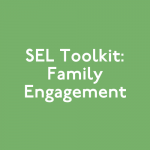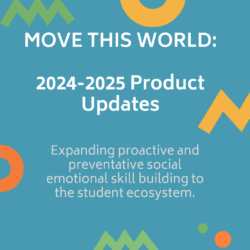In some states and districts, schools are planning to reopen and welcome students back to a traditional learning environment. However, even starting the school year back in classrooms on campus will be different this fall!
In order to safely return to school campuses, students and staff may experience changes in their daily routines. Whether having to wear masks throughout the day, requiring temperature checks, or staying in one classroom instead of traveling to various rooms for different classes or electives, educators are thoughtfully trying to make sure that they can reopen and maintain social distancing when possible. However, these changes might make students feel scared or anxious entering the school building.
Not all educators or parents will be comfortable with the risks in a traditional learning environment, so maintaining regular communication and clear expectations can help alleviate some of the anxiety that communities may feel. A strong social emotional learning plan can help your community feel confident returning to classrooms, ease the transition back to school, and help students and educators process the events of the past few months.
Here are 3 considerations for SEL when returning to a traditional learning environment:
1. Providing daily SEL instruction and practice to foster a sense of belonging and safety as students return to close proximity with others.
Besides fostering a sense of community, providing dedicated time and space to process feelings allows students to “clear the deck,” so to speak, so they can transition from a global crisis back into a classroom setting. Families may have experienced the death of a loved one, illness, economic hardship, or other stressors during this time. Creating dedicated time and space for SEL also allows you to identify students who may need additional support as they transition back to school.
Be prepared to help students process their feelings around the pandemic itself. Active listening is important as students share, especially since there have been strong opinions about the pandemic in the media, online, and in our communities. Students may not have had an opportunity to share their feelings in a safe environment. Use our Current Events activity to help students think more critically about how they feel about the news surrounding the global pandemic.
2. Emphasize school culture and rethink school-wide celebrations and traditions.
Returning to campus doesn’t necessarily mean returning to school life as usual. Schools may still be practicing social distancing or limiting exposure by canceling large gatherings. Students may have questions about why school feels different, and why they have new routines. Provide space for students to process and share their feelings about returning to school, and check in with them regularly as the environment shifts.
Older students can play a significant role in maintaining school culture. Invite them to share ideas about how to build connections and rethink school-wide celebrations and traditions. Building student connections across grade levels can be an alternative way to create a sense of community when you can’t gather in large groups.
3. Make your safety measures visible for students and clearly communicated to families.
Around campus, friendly and welcoming visuals can help students adjust to their new environment. Teachers can put their pictures and pictures of their class on classroom doors so there are smiling faces in the hallways, since students may be interacting with other classes less frequently. Post motivational signs with school slogans or colorful reminders that “we’re in this together!” Your safety measures are just that – to keep students safe – and that’s a good thing! Remind students that their safety matters because they are important and cared about. Ground your safety measures in love and respect, and make these messages visible throughout your school building.
Remember that not all parents will be comfortable sending their students back to school, and returning to the classroom may not be safe for all students. A child who lives with a pre-existing condition or physical illness can easily feel excluded when all of their classmates return to school but they cannot. Have a plan in place to support and include these students, and encourage teachers to treat these families with compassion.
Download our SEL Toolkit: Planning for Reentry to read more considerations for SEL as you return to the classroom, including printable resources.
Regular, systemic social emotional learning provides all students and staff with a common language to discuss emotions. As you begin to build new routines and adjust to added safety measures, improving the emotional awareness of your school community can help you identify needs or challenges that your community is facing, as well as build a sense of community. A common vocabulary around emotions leads to more communication, helping students advocate for themselves and empowering teachers to better support students in the classroom.
Video-based social emotional learning allows students and teachers to practice SEL together. Instead of having to “fit something else in” or facilitate a lesson, video-based programs like Move This World make implementation easy for teachers and students. Learn more about how Move This World works here. Or, fill out the form below to learn more about implementing Move This World in a traditional classroom environment with safety modifications for 2020-21.
[pardot-form id=”2502″ title=”Resource Download_Implementing MTW_Traditional”]










